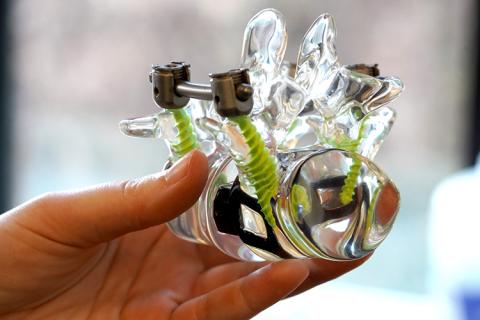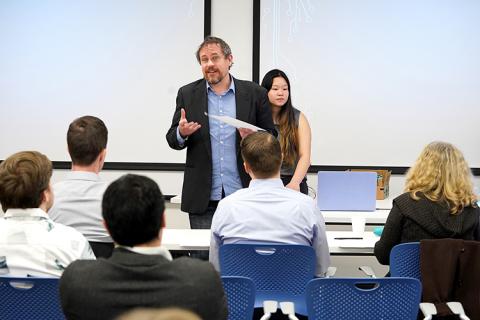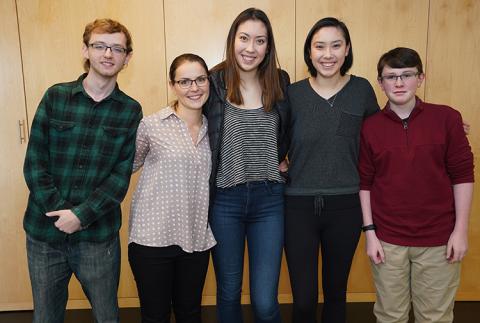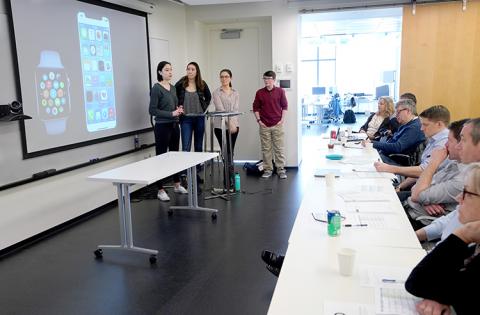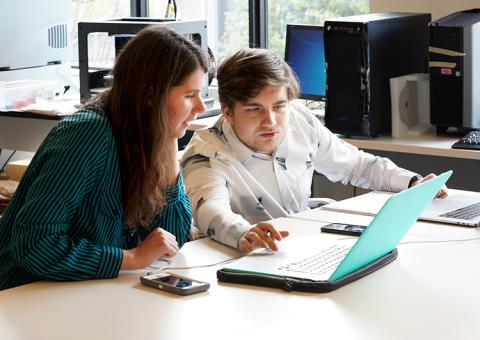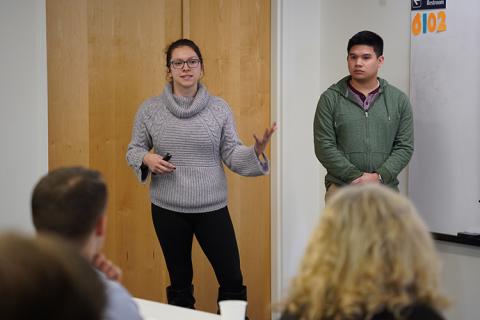This CNT-led and facilitated course at the University of Washington teaches students about engineering design principles, particularly the importance of empathizing with neurotechnology end users.
Prior to entering his role as the Director of Industry and Innovation at the Center for Neurotechnology (CNT), Scott Ransom spent 20 years at Medtronic working in a range of roles related to medical device development.
“There wasn’t a week where a patient or their relatives weren’t expressing gratitude for the work we were doing,” Ransom said. “It was very fulfilling to see patients benefit. I want to inspire students to use bioengineering, electrical engineering [and other disciplines] in the neurotechnology space. I can’t imagine a more fulfilling career.”
To support other students in exploring projects in neurotechnology, Ransom teaches Neural Engineering Tech Studio, a course at the University of Washington (UW) that’s offered annually. The course began in 2013 as a CNT competition called the Tech Sandbox, and it became an official course at the UW in 2016. The current version of this course is still held at and facilitated by the CNT, and it invites students to work in teams to identify an engineering problem, design a neural engineering prototype that addresses that problem, and present their idea to a panel of industry judges.
Ransom put students in teams to ensure that they had a good balance of disciplinary expertise from bioengineering, electrical and computer engineering, computer science and psychology. He said that the collaborative environment reflects the reality of working in industry.
“[This class prepares you to] see a problem, work with your team to come up with ideas, think critically about how to solve that problem and find the resources to bring it [a solution] to life,” said Rachael Tessem, a senior in bioengineering.
The class teaches students about engineering design principles, particularly the importance of empathizing with neurotechnology end users. Students also learn important entrepreneurship skills such as how to conduct market research, present to potential investors and write proposition statements about how a product supports an end user.
“Coming into the class, most people were on the engineering side. Because we had experience with making products but not the business side, those lectures supplemented our understanding of how we should be thinking about these products,” said Vinny Palaniappan, a senior studying computer science and neuroscience. “If we were to take this into the real world, how would we do that in the best way possible?”
Designing forward-thinking, user-centered products
Ransom said it’s important for students to understand what a patient or customer needs through conversation.
“[The goal is to help students] not just see a device as a collection of features, but something that can change people’s lives for the better,” Ransom said.
Through the design and prototyping process, students conducted interviews with potential end users and tested hypotheses about the value propositions they developed. For example, Palaniappan’s team met with physical therapy patients and physical therapists. In the process, the team learned about common problems with physical therapy like the lack of customization and the challenge of motivating patients to do their exercises.
“When we looked into the data, we found that it was incredibly common for people to not to do their exercises or go to physical therapy when it was necessary,” Palaniappan said.
Because Tessem’s intervention focused on creating relief for people with panic attacks, Ransom connected their team to his son, Noah, a 15-year-old who has panic attacks that can lead to seizures. The team interviewed Noah to gain an in-depth understanding of the timeline of panic attack onset, as well as his current triggers, coping mechanisms, and opinions regarding their specific prototype features. Noah’s perspective supported the team’s understanding of the problem space and encouraged them to redirect their design goals to fit customer needs.
Receiving mentorship and resources
Throughout the class, students had access to a $300 budget to develop their projects as well as the 3D printer, soldering irons and laser cutters from the CNT. To develop their projects, teams had access to electroencephalogram (EEG) headset supplies from Advanced Brain Monitoring, sensing equipment from OpenBCI, AR/VR headsets from Microsoft, and other materials from the CNT.
During the engineering design phase, students received feedback and support from industry mentors with a range of expertise in medical devices, engineering, entrepreneurship and clinical settings.
“Being able to get that feedback from industry mentors allows the student teams to draw on 20, 30 or even 40 years of experience and use that knowledge in their project,” Ransom said.
During this phase of the class, Palaniappan’s team pitched a universal remote that could control a range of appliances. He said that the industry mentors were helpful in assessing the market value of their potential product and identifying next-steps.
“We didn’t consider [if] other people would want it beyond us. Getting that perspective helped us move to something that was more focused,” Palaniappan said.
He also said that the most helpful resource was the supportive and collaborative class environment, which encouraged creativity and learning from others.
“It’s a good environment for exploring engineering and prototyping,” Tessem said. “It feels like there are no limits.”
Pitching ideas to industry experts
On the final day of class, the student teams pitched their ideas to a panel of CNT industry affiliates. The judges evaluated the teams based on their project’s value proposition, usability, and effectiveness.
To address the lack of compliance with physical therapy regimens, Palaniappan’s team, Myovate, created a hardware and app system that uses customizable electromyography (EMG) sensors to measure muscle signals, which can be used to play video games. The judges complimented the team’s use of gamification for these exercises, and also invited them to think more deeply about the specific audience that would use it.
Tessem’s team, PanicAway, prototyped a smart phone app which could track heart rate and provide automatic visual, audio, and/or vibrotactile therapy during a panic attack. During their pitch, Noah provided insight into his own panic attack symptoms and praised the app’s ability to provide automatic and customizable support during a panic attack or anxiety-inducing scenario.
Team Mentoci began their presentation by explaining that the average student’s attention span is 10 minutes, especially with the increased presence of distracting technology. In response, they decided to develop a custom headset that measures brain signals and provides teachers with data, tools and real-time feedback about their student’s engagement level. The judges highlighted the desirability of their system because teachers could use it to change their teaching in real-time.
Team Kioku also focused on learning, but they chose to use artificial intelligence to create visualizations for the user. Their target audience was pre-medical or medical students who take memorization-heavy exams, and the team also saw their device as a potential intervention for patients with traumatic brain injuries or depression. The judges complimented the originality of their device and the way it used underlying principles of neuroscience for a product, and the team was encouraged to focus on users with memory problems.
To target people with chronic insomnia disorder, team Aurora focused on people with insomnia and other sleep problems, which impact 50 to 70 million Americans. To support these people in early stages of sleep, they created a device that takes in EMG sensor data. If the user is awake, the device will turn on a sleeping aid like a fan or heating pad. The judges said that the team’s sleep optimizer had potential marketability for a broad user group and encouraged them to think about when it could be selectively turned on or off.
Team Frequent Fusion focused on an intervention that’s an augmentation to spinal fusion surgery, which is used to fuse bones in the spinal cord to reduce chronic neck pain. The team designed a fully implantable device that stimulates bone growth, follows FDA protocol, and supports the patient’s needs. During their presentation, the team received questions about who would be the primary decision-maker for adopting their proposed device.
The winning team was PanicAway, which included members Rachael Tessem, Renae Tessem, Ashley Fogwell and Dylan Jensen. The judges said the team was chosen for demonstrating a deep understanding of their user group, the potential their prototype had to address an unmet medical need, and the value of the positive feedback from a potential end user about their application.
Ransom encouraged PanicAway to continue developing their project through support and mentorship from the CNT, UW CoMotion and the UW Buerk Center for Entrepreneurship.
“If you take your devices farther than this class, let me know. We want to be a continued source of support to help your ideas beneficially impact people,” Ransom said.
For more information about Neural Engineering Tech Studio, contact Scott Ransom.

